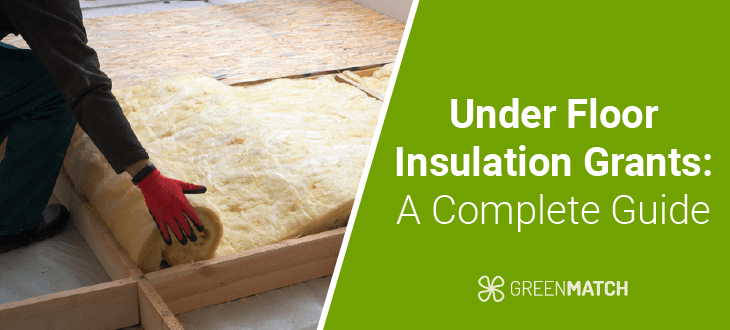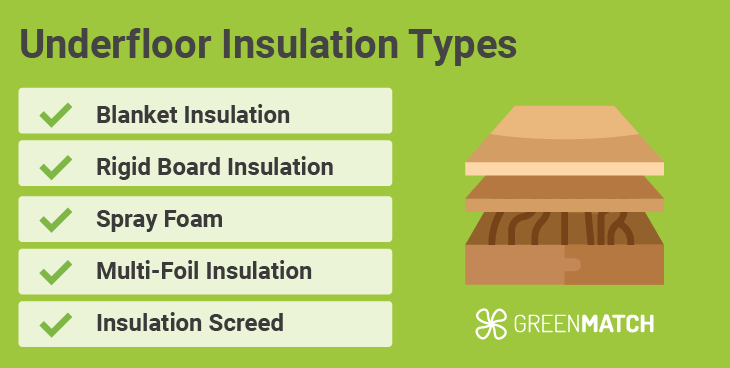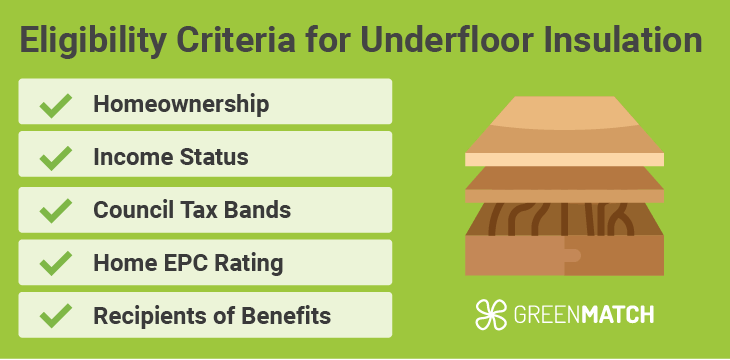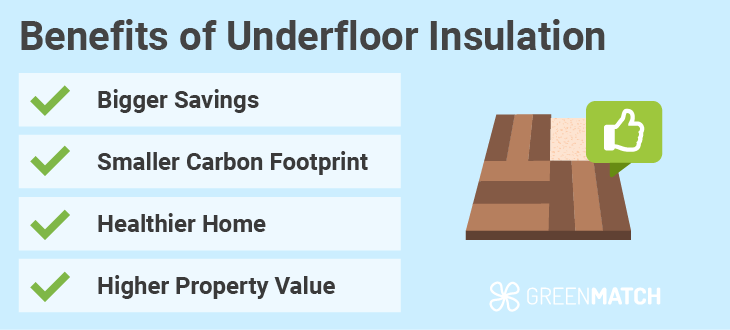Answer these simple questions and we will find you the BEST prices
Which type of solar quotes do you need?
It only takes 30 seconds
100% free with no obligation

Get Free quotes from insulation specialists near you

Save money by comparing quotes and choosing the most competitive offer

The service is 100% free and with no obligation
- GreenMatch
- Insulation
- Insulation Grants
- Underfloor Insulation Grants
Under Floor Insulation Grants: A Complete Guide


- A typical suspended timber underfloor insulation can cost around £4,700.
- Underfloor insulation can save a detached home up to £100 in annual energy bills.
- The Great British Insulation Scheme (GBIS) and the Energy Company Obligation (ECO4) both provide free and reduced-cost underfloor insulation.
Underfloor insulation is a highly effective way to reduce home heat loss further and improve domestic efficiency, leading to lower energy bills, more savings, a cosy home, and a smaller carbon footprint.
However, not everybody can afford to invest in insulation. Luckily, the UK government has rolled out two key grant schemes in line with its ambitious Net Zero by 2050 carbon target. These are the Great British Insulation Scheme (GBIS) and the Energy Company Obligation (ECO4).
This ultimate guide by GreenMatch UK will give you everything you need to know about securing underfloor insulation in the UK, complete with grant types, provisions, eligibility criteria and the application process.
Ready to get your floors insulated? Let GreenMatch UK take care of it for you. Instead of spending endless hours researching and vetting installers, spend just 30 seconds filling out our simple form, and we’ll send you up to 3 free home-tailored quotes from trusted installers in our network. Click the button below to begin!
- Describe your needs
- Get free quotes
- Choose the best offer
It only takes 30 seconds



- What are underfloor insulation grants?
- Government grants for underfloor insulation in the UK
- Eligibility criteria for free underfloor insulation grants
- Benefits of obtaining an under floor insulation grant
- Is your home suitable for underfloor insulation?
- How can you apply for free underfloor insulation?
- Find under floor insulation installers near you
- FAQ
What are underfloor insulation grants?
Government grants for insulation are aimed at helping low-income, fuel-poor, and energy-inefficient households with financial assistance towards under floor insulation. While there isn't an exclusive grant programme for floor insulation, two main grant schemes in the UK provide it.
These are the Great British Insulation Scheme (GBIS) and the Energy Company Obligation (ECO4). Both schemes exist to help qualifying households with free and low-cost insulation measures to improve their thermal efficiency.
Homes with efficient insulation will save drastically on energy bills, lower their domestic carbon emissions, and improve the comfort of their living environment.
Types of underfloor insulation

There are several types of underfloor insulation materials depending on your home type, budget, and personal needs.
Most floors suitable for this style of insulation have suspended timber floors, or an underfloor cavity, both of which can house insulation material comfortably.
- Blanket insulation: Costing around £13 - £18 per m2, these insulators are made from rock or glass minerals and are popular for their budget-friendliness. They come as batts or blankets and can be laid in between the floor joists under floorboards and covered up.
- Rigid board insulation: Rigid boards can be found made from materials such as PIR (polyisocyanurate) or PUR (polyurethane), and cost an average between £15 - £17 per m2. They’re renowned for their impressive insulation capabilities and easy handling.
- Spray foam: Most commonly made from polyurethane, this expanding foam costs around £22 - £26 per m2 and is an extremely good heat insulator. It can be injected into the underfloors where it expands to fill the cavity spaces between floor joists.
- Multi-foil insulation: Costing just £3 - £4 per m2, multi-foil is made from several layers of aluminium bonded with foam insulation. While not as effective as some other insulators, its affordability makes it an appealing option for underfloor insulation.
- Insulation screed: Priced around £18 - £20 per m2, screed is a mixture of cement, sand, and water that’s usually applied on top of solid floors to create a level ground, however, it also carries minor thermal insulation properties. While not very suitable or advised for under floor insulation, it can still be done.
Add lots of rugs and carpets to your floors for added thermal and sound insulation. These are handy in boosting your home’s thermal capacity and muffling external noise. Plus, a good rug can add great aesthetic value to your interior.
Suspended timber floors
Suspended timber floors are very common in older builds and consist of floor joists with wooden floorboards laid on top. You can identify if you have suspended timber floors by checking under your floorboards or looking at the ceiling from the floor below to find the floor joists.
These floors are very easy to insulate, by simply lifting the floorboards, and applying the insulation material in between the floor joists.
Solid floors
Newer builds tend to have solid concrete floors with no under floor cavity. These naturally cannot be insulated by placing insulation material under the floor.
In these circumstances, the insulation material is laid on top of the concrete floor, coated in screed or plaster, and then covered in laminate or floorboards.
Materials like spray foam or mineral wool are generally not suitable for solid floors, but rigid insulation boards are a perfect fit for this style of insulation.
Government grants for underfloor insulation in the UK
In the UK, there are currently two key grant schemes that provide grants for underfloor insulation. These are the Great British Insulation Scheme (GBIS) and the Energy Company Obligation (ECO4).
Both schemes aim to help low-income, fuel-poor, and energy-inefficient households with domestic efficiency upgrades but do so in slightly different ways.
Homes that are not connected to the gas grid and instead heat with alternatives like oil, coal, or electricity can use the Home Upgrade Grant (HUG). This scheme can only be applied via your local council and requires their approval after a house assessment.
The grant scheme is only eligible for homeowners without gas boilers, a low-income range, and those with a home EPC rating of D or below. To apply, contact your local council or visit the official UK government website.
Great British Insulation Scheme (GBIS)
The Great British Insulation Scheme, or GBIS scheme, is a government grant scheme that aims to deliver a single insulation measure per qualifying household, including under floor insulation.
This is to maximise the scheme's reach across the UK, in line with the goals to reach Net Zero by 2050. The measure of choice is tailored to each specific house, decided after a house retrofit assessment to determine the most effective means of improving a home's thermal efficiency.
Energy Company Obligation (ECO4) Scheme
The Energy Company Obligation (ECO4) is an Ofgem-administered obligation placed on energy suppliers in the UK to assist qualifying households with domestic upgrades.
Different to the GBIS, the ECO4 takes a more whole-house approach to improvements, offering a range of upgrades such as insulation measures, but also energy system repairs, upgrades, and even smart controls.
Homeowners can expect full coverage for low and mid-tier insulation upgrades, but complex expensive jobs may require a portion of financial contribution from the household. This all depends on your qualification for the scheme.
Eligibility criteria for free underfloor insulation grants

Both the GBIS and ECO4 schemes prioritise households that are low-income, fuel-poor, and energy-inefficient, but may have slight differences in their qualification criteria.
Here are some of the key qualification criteria you could expect when applying to either scheme:
- Homeownership: To apply for underfloor insulation grants from either the GBIS or ECO4, you need to be a homeowner or a renter from a private landlord. You also need to be actively residing in the household.
- Income status: The priority for both schemes is households that are in the low-income category. These are homes with a gross annual income of less than £31,000.
- Council tax bands: Another indicator of financial standing is your property value. Council tax bands tell you the worth of your property and how much local tax you have to pay on it. Homes in tex bands A - D in England, and A - E in Scotland and Wales can qualify for grants.
- Home EPC rating: An Energy Performance Certificate tells you how efficient your home is. Homes are rated from A (most efficient) to G (least efficient). Homes with an EPC rate below D are very likely to qualify for grant schemes.
- Recipients of government benefits: Homes with residents that receive specific government benefits are likely to receive assistance from a grant scheme. These are mainly means-tested benefits.
At the moment, several means-tested benefits are explicitly recognised as grant-eligible in the UK, they are as follows:
- Income-based Job Seekers Allowance
- Income-related Employment and Support Allowance (ESA)
- Income Support
- Pension Credit
- Guarantee Credit
- Working Tax Credit
- Child Tax Credit
- Universal Credit
- Housing Benefit
Benefits of obtaining an under floor insulation grant

Underfloor insulation provides a wealth of benefits for your home. These include savings, living comfort, house value and much more.
Here are just some of the key benefits you could enjoy with underfloor insulation in your home:
- Bigger savings: Proper underfloor insulation can save a detached household up to £100 every year in energy bill savings. This makes underfloor insulation a great means of reducing energy bills for decades to come.
- Smaller carbon footprint: A detached home can reduce its domestic carbon footprint by 0.3 tonnes every year just with underfloor insulation. Combined with other insulation measures, you can drastically help keep the planet healthy.
- Healthier home: Proper insulation helps prevent condensation and indoor moisture, key causes in mould and rot development. Not only do you prolong your home life, but help protect your health by reducing the risk of respiratory illnesses.
- Higher property value: Insulated homes with a higher EPC rating are
With all these benefits considered, underfloor insulation emerges as a wonderful home upgrade with a wealth of positive improvements to your savings, lifestyle, and the planet.
Is your home suitable for underfloor insulation?
To simply know whether your home is suitable for under floor insulation, you need to confirm that you have the right type of floor. Typically, suspended timber floors or panelled floors with a cavity space under them are suitable for under floor insulation.
You can check if you have suspended timber floors by lifting your floorboards and identifying the floor joists beneath. In some homes, you can also see these floor joists from the floor or basement below.
Floor joists are horizontal beams that span the floor length and support the floorboards on top.
Next up, it’s important to make sure your floor joists and boards are in good condition and do not need replacing. For this, it’s best to undergo a house assessment by a professional.
If you qualify for a grant scheme, working with an accredited installer will ensure they thoroughly check your floor condition and deliver high-quality insulation results.
How can you apply for free underfloor insulation?
Applying for free underfloor insulation grants is relatively easy, but requires different steps depending on the grant scheme you are applying for.
Here’s what to expect per grant scheme:
- Great British Insulation Scheme (GBIS): You can apply for the GBIS directly through the official UK government website. There, you can fill out an online application form, or contact the scheme administrators via email or telephone number.
- Energy Company Obligation (ECO4): The ECO4 scheme can be applied by contacting your energy supplier, as they are obliged to provide households with upgrades. Once contacted, a housing assessment will be arranged to determine your needs.
As for non-gas heated homes that intend to make use of the Warm Homes Local Grant, your local council is required to submit approval on your behalf. You can kickstart this process by contacting your local council and arranging a house inspection.
Find under floor insulation installers near you
Deciding to get under floor insulation is a great step, qualifying for insulation grants for homeowners is even better, but landing a professional accredited installer is really where the magic happens.
A professional installer is the difference between a high-quality job and a shabby installation that becomes a never-ending burden of repair costs and home damage.
Homes that qualify for a grant are obliged to work with a PAS 2030-2035 certified installer. The Publicly Available Specifications (PAS) are a series of industry standards that recognised installers meet, ensuring you receive professional workmanship.
However, finding a quality installer at the right price can sometimes feel like looking for a needle in a haystack. That’s where GreenMatch UK can help you out.
Instead of spending endless hours researching and vetting installers, just spend 30 seconds filling out our online form, and we’ll send you up to 3 free home-tailored quotes from installers in our nationwide network. No charges or obligations. Click the button below to begin!
- Describe your needs
- Get free quotes
- Choose the best offer
It only takes 30 seconds



FAQ
Under floor insulation is a great move for any home that has suitable floors for the job. It can cut up to 8% of home heat loss and boost your energy bill savings significantly.
You can get a grant for under floor insulation through the Great British Insulation Scheme (GBIS) or the Energy Company Obligation (ECO4) if you meet the qualifying criteria. For homes that are not connected to the gas grid, there is also the Home Upgrade Grant (HUG) that can be applied for via your local council.
Eligibility for under floor insulation is usually prioritised for low-income, fuel-poor, and energy-inefficient households. If you fall into the low-income category, have a home EPC rating below D, and are a recipient of government benefits amongst other indicators, then chances are you are likely to qualify for an underfloor insulation grant.
The main government grants for underfloor insulation are the Great British Insulation Scheme (GBIS) and the Energy Company Obligation (ECO4). There is also the Home Upgrade Grant (HUG) which is intended to provide insulation upgrades for non-gas heated, off-grid homes.

Akif is a copywriter at GreenMatch since 2023. With a keen interest in community sustainability, green solutions and the role of digital media in identifying climate trends, he aims to hone in on his background in International Studies and Digital Media to provide a multidisciplinary approach to written content rooted in credible research and accuracy.
We strive to connect our customers with the right product and supplier. Would you like to be part of GreenMatch?

- Under Floor Insulation Grants: A Complete Guide
- What are underfloor insulation grants?
- Government grants for underfloor insulation in the UK
- Eligibility criteria for free underfloor insulation grants
- Benefits of obtaining an under floor insulation grant
- Is your home suitable for underfloor insulation?
- How can you apply for free underfloor insulation?
- Find under floor insulation installers near you
- FAQ
